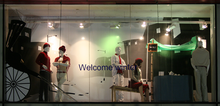
The Two Most Important Elements of Visual Merchandising
 Visual merchandising is essential when running a brick-and-mortar retail store or business. It allows store owners to present their products in a more appealing manner; thereby, encouraging shoppers to buy them. While there are dozens of different elements associated with visual merchandising, none of them hold as much importance as interior and exterior displays.
Visual merchandising is essential when running a brick-and-mortar retail store or business. It allows store owners to present their products in a more appealing manner; thereby, encouraging shoppers to buy them. While there are dozens of different elements associated with visual merchandising, none of them hold as much importance as interior and exterior displays.
Both interior and exterior displays are intended to capture shoppers’ attentions, encouraging them to enter the store and buy the presented product. According to a study published in the Journal Of Business & Retail Management Research, interior and exterior displays have the greatest effect on impulse buying, attesting to their importance in the retail setting. Of course, this shouldn’t come as a surprise given the fact that product displays are the first and last thing a shopper sees when visiting a store.
Interior Displays
Interior displays often consist of mannequins displaying garments, accessories and other products sold by the store. Even if the store doesn’t sell clothing, it may still use mannequins to present its products. Sports stores, for instance, will often use mannequins to display baseball, football and other sports equipment. With that said, however, this doesn’t necessarily mean that all interior displays consist solely of mannequins. Interior displays may also include signs, cardboard cutouts, and similar elements. In addition to boosting sales, such interior displays may improve customer satisfaction while boosting the store’s aesthetics.
Exterior Displays
Exterior displays may also consist of mannequins displaying garments, accessories and other products sold by the store. One of the nuances between interior and exterior displays is the space. Interior displays typically are typically larger because of the greater floor space. This means store owners must carefully construct their outdoor displays in a way that makes the best possible use of the available space. With a finite amount of space, exterior displays must be carefully constructed to ensure a positive response among the store’s target demographic.
Another difference between interior and exterior displays lies in the function: interior displays are used to draw to shoppers to a particular product or area of the store, whereas exterior displays are typically used to draw shoppers into the store. As such, many retail store owners will use bold, bright-colored signs in their exterior displays.
If you have any questions at all about visual merchandising, please give us a call at 800.241.6897 or email us at /contact-us/.



